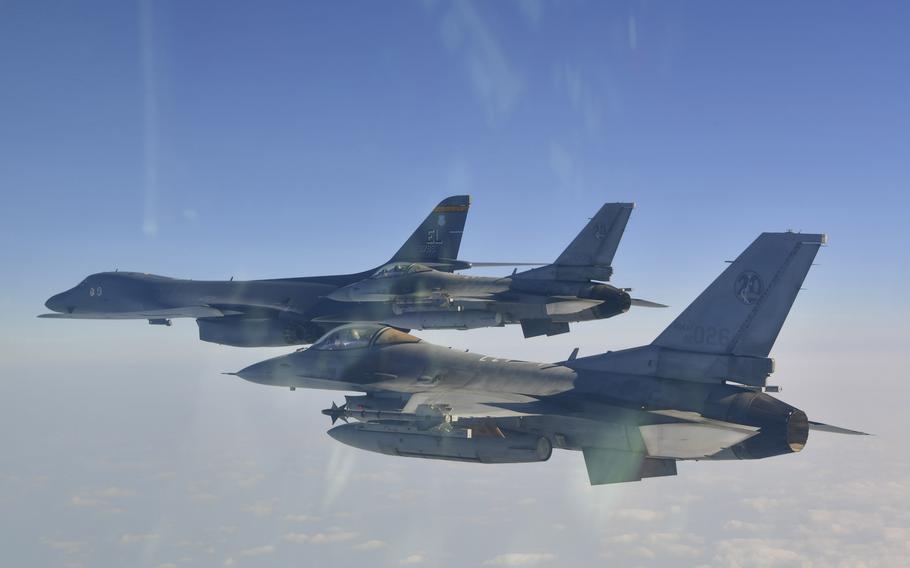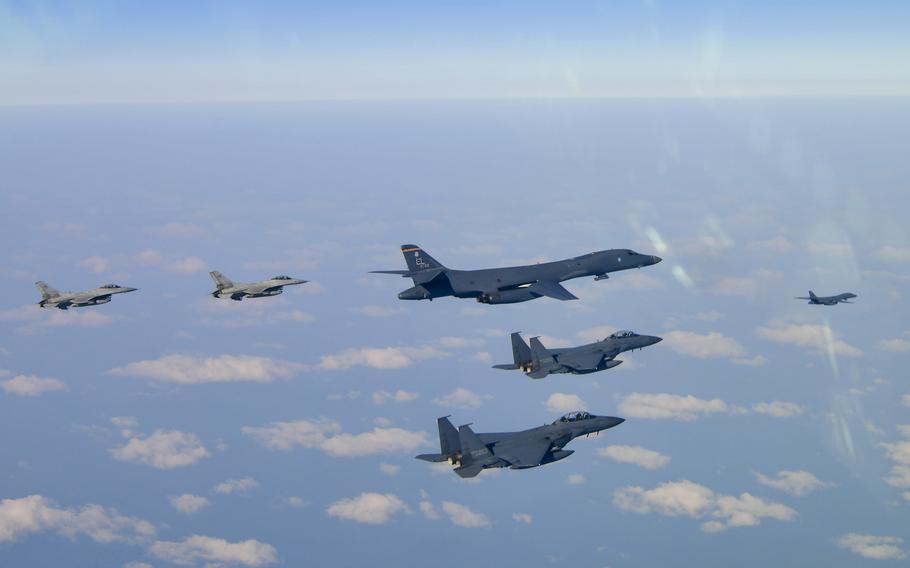
Two U.S. F-16 Fighting Falcons fly alongside a B-1B Lancer over South Korean airspace, Feb. 20, 20225. (South Korean air force)
CAMP HUMPHREYS, South Korea — The U.S. and South Korean air forces demonstrated their combined air power with American bombers over South Korean airspace Thursday to “deter and respond to North Korea’s threats,” the South’s military said that day.
Two B-1B Lancers out of Andersen Air Force Base, Guam, flew alongside three U.S. F-16 Fighting Falcons from Osan Air Base, South Korea, four Marine Corps F-35Bs from Marine Corps Air Station Iwakuni, Japan, and four South Korean F-35As and F-15K Slam Eagles, according to news releases Thursday from the U.S. 7th Air Force and South Korean Ministry of National Defense.
The bomber escort and air interdiction drill showcased the two countries’ ability to “deter and respond to North Korea’s nuclear and missile threats,” the ministry said.
Seventh Air Force commander Lt. Gen. David Iverson said the drill “ensures we’re able to maintain the high levels of readiness necessary for our combined defense posture,” according to the command’s release.
South Korea’s Ministry of National Defense and U.S. Forces Korea, the command responsible for 28,500 U.S. troops on the peninsula, does not disclose flight plans or ship movements in advance, citing security concerns.
Thursday’s drill marks the year’s first aerial demonstration by the two allied militaries.

Two Air Force B-1B Lancers fly alongside F-16 Fighting Falcons and South Korean air force F-15K Slam Eagles over South Korean airspace, Feb. 20, 2025. (South Korean air force)
Last month, a pair of Lancers were escorted by two Japanese Mitsubishi F-2s and two South Korean F-15K Slam Eagles over the Sea of Japan, also known as the East Sea.
The three countries kicked off trilateral air drills starting Oct. 22, 2023, after then-Japanese Prime Minister Fumio Kishida and then-Presidents Joe Biden and Yoon Suk Yeol of South Korea pledged to coordinate their defenses in light of North Korean threats.
That historic drill included a B-52H Stratofortress bomber; two F-16 Fighting Falcons; two South Korean F-15K Slam Eagles; and two Japanese F-2s in air defense zones overlapping Seoul and Tokyo.
North Korea has continued to levy threats against South Korea and the United States. The state-run Korean Central News Agency on Saturday reported the North will continue “bolstering” its nuclear capabilities to defend itself.
“As long as the U.S. and its vassal forces’ hostile threat exists, [North Korea’s] nukes are … a means for legitimate self-defense entrusted by the constitution of the state,” the report said.
North Korea most recently fired several short-range ballistic missiles on Jan. 14 that flew approximately 155 miles before splashing down in the Sea of Japan, the South’s military said that day.
About a week later, the communist regime launched several cruise missiles that flew 930 miles, KCNA reported Jan. 26.